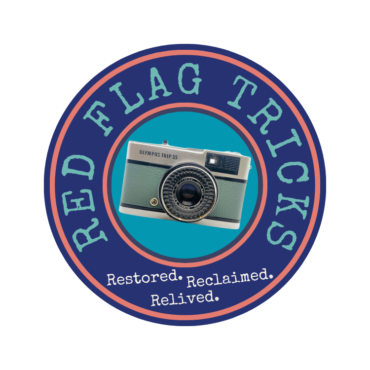Here are 10 interesting “wonders” about this iconic camera

I’ve put down some of the things that I think make the Olympus Trip 35 so special given its popularity, longevity and mass love from the photographic community… as well as my little thoughts on what I find when I open these cameras up and make them perform like new again
1. Designed for Travelers and Adventurers!
The Olympus Trip 35 was explicitly marketed to travelers, as its name suggests. Its compact, lightweight design (approx. 410g) made it an ideal companion for those on the go, ensuring it could be easily carried without the bulk of larger SLR cameras. It’s robust full metal body stood up to the rigours of street photography, mountain climbs and hot days on the beach. I smile every time I open up a viewfinder and see sand and various other bits of grit as reminders from the cameras travels… the viewfinder housing is a magnet for history keepsakes, especially later models that replaced a paper cover on top of the viewfinder to an insulating tape cover that caught the grit and dirt on the sticky side.

2. Solar-Powered Selenium Light Meter
One of the most innovative features of the Olympus Trip 35 is its solar-powered selenium light meter. This allowed the camera to function without batteries, using the power of light to operate the exposure system. This was particularly convenient for travelers who didn’t want to worry about running out of battery power or travel with batteries on planes and trains etc. It’s a pocket-sized, self-sufficient masterpiece.
There is a lot of chitter chatter in blogs and online forums about the light meters on these cameras failing due to age and exposure to sunlight depleting the cells… and so killing the camera for good. In truth, the selenium cells never really suffer over time, or by sunlight, but the selenium cell wiring deteriorates… and if the camera has been subjected to strong UV light for long periods of time, then the wires, solder points and wire insulation can break down and this can cause a problem… BUT… “The Trip 35 is notorious for Dead Selenium Cells” is, in my opinion, fear mongering… I would say that 95%+ of cameras available today, stored well are completely fine. In all my time repairing and servicing these cameras, I have had just two light meter fails and that was more to do with me making the wrong purchase decision in the first place.
Top Tip – buy a Trip that has been stored with a lens cap on in a bag or pouch.
If you are interested in buying an Olympus Trip 35 – read my handy buying blog here… https://olympustrip.co.uk/the-olympus-trip-buyers-guide/

3. High-Quality Zuiko Lens
The Zuiko lens on the Olympus Trip 35 was engineered with precision to ensure high performance in a compact and affordable package. Olympus engineers felt that the quality of the lens would set the Trip 35 apart from the ever-expanding compact point and shoot marketplace at the time. It features a 40mm focal length with a maximum aperture of f/2.8, designed to provide sharp and well-exposed images even in low-light conditions. This means that the Trip is quite capable of taking low light photographs when other cameras required flash. The lens uses a simple yet effective four-element construction in three groups, a design that maximizes optical clarity while minimising distortion and chromatic aberrations.
To enhance image quality, the lens was multi-coated, which helped reduce lens flare and ghosting, improving contrast and colour saturation, crucial for outdoor photography. The aperture adjusts from f/2.8 to f/22 depending on light conditions, ensuring consistent exposure, and as mentioned, without needing batteries!
Olympus engineers also prioritised durability, using high-quality glass and robust materials for the lens construction. This engineering balance between simplicity and functionality made the Zuiko lens a significant factor in the Trip 35’s enduring popularity. Its reputation was further cemented by public endorsement from photography enthusiasts and professionals alike, including a notable ad campaign featuring British photographer David Bailey. This legacy of design excellence has made the Zuiko lens and the Trip 35 iconic among film camera collectors today.
Probably one of the most satisfying aspects of stripping and servicing a Trip 35 is getting the lens and elements back to near the same condition as they were when they left the factory. I like to work on cameras that really awful and have it all – Haze, Mold, Dust and Grease… it takes time and patience but the results can be amazing.


4. Red Flag Warning System
The Olympus Trip 35’s Red Flag system is a clever safety mechanism designed to prevent underexposure in poor lighting conditions. When the camera’s selenium light meter detects insufficient light for a correct exposure, a red flag appears in the viewfinder, and the shutter locks, preventing the user from taking a photo with an incorrect exposure. This simple but effective system made the Trip 35 especially user-friendly, as it required no batteries (another mention), and ensured that users wouldn’t waste film on poorly exposed shots.
However, the Red Flag system has its limitations. Over time, the selenium cell components that power the light meter can degrade, leading to inaccurate light readings or as stated previously, in rare cases complete failure. In these cases, the Red Flag may no longer engage, allowing users to take underexposed photos without warning. Another common issue arises from mechanical wear in the camera, where the linkage between the meter and the flag can become stiff, covered in grease, dust, dirt or fail entirely. When this happens, the flag might not appear even in low light, defeating its protective purpose. Another problem I come across is where the Red Flag arm under the front camera plate is obstructed from lifting by the side of the cover plate itself, or it catches on loose wiring. This is a quick fix that a lot of people miss… and once resolved the red flag works like new again. I always clean the red flag when servicing a camera as it is another dust trap.
While repairable, the mechanical parts involved can make restoring the Red Flag system challenging, yet very satisfying at the same time.
5. Durability and Longevity
The Olympus Trip 35 is renowned for its exceptional durability, owing largely to its rugged construction and thoughtful engineering. The camera’s body is crafted from high-quality metal, offering a solid feel while remaining lightweight enough for portability. You can feel the quality of Trip 35 just by holding it in your hands. It just feels solid.
Its compact size and ergonomic design made it ideal for travel, while the black leatherette skin that covered the body provided both aesthetic appeal and extra grip for handling in various conditions. This durable outer coating ensured that the camera could withstand the bumps and scrapes of daily use without losing its iconic appearance. These “black skins” have survived incredibly well in most cases, and where not I can recover them to make them look like new again. I’m also working on a way to recover the Trip 35 in a material very similar to the original. Watch this space!!!
Internally, the Trip 35’s mechanisms were engineered for long-lasting reliability. The film advance lever, for example, operates with a smooth, precise winding action, a reflection of Olympus’ attention to mechanical detail. This winding mechanism was built with metal gears that have stood the test of time, remaining functional in most cameras even decades after their production. However, the top cogs in some models are plastic and I have always wondered why this was not engineered better as it can crack if forced… especially when the camera is loaded with film and a jam causes resistance to the winder.

6. Lens settings / Feel
The settings rings around the lens, which control aperture, focus, and ASA/ISO, are another example of Olympus’ commitment to quality. These rings are constructed from sturdy metal and rotate with a satisfying click, providing tactile feedback and precision in adjustment. Unlike some plastic-bodied cameras from the same era, the rings on the Trip 35 resist wear and maintain their smooth functionality.
The viewfinder, though simple in design, is clear and bright, making composition easy in various lighting conditions. Its solid construction adds to the overall resilience of the camera, contributing to its reputation as a camera that just keeps working. Thanks to its top-notch build quality and thoughtful design, the Olympus Trip 35 remains a favourite among film enthusiasts today, with many still in perfect working condition after half a century of use in the toughest of conditions.
7. Mass Production Peculiarities
The Olympus Trip 35 was produced from 1967 to 1984, during which time it underwent several changes in both engineering and aesthetics. While the core functionality and design remained consistent, Olympus made subtle modifications to streamline manufacturing and adapt to evolving consumer preferences.
In the early years, the camera was crafted with a chrome metal body and high-quality metal parts throughout, ensuring durability. However, as production ramped up and the camera gained massive popularity, Olympus introduced cost-effective measures to maintain affordability. For instance, later models of the Trip 35 began incorporating more plastic components, particularly in the internal mechanisms, while still preserving the robust functionality and feel of the original. These changes were mainly seen in the winding mechanism, where some plastic gears replaced metal ones in later versions, though the camera’s performance remained reliable.
The Olympus Trip 35 saw an increase in its maximum ISO setting from 200 to 400 in the early 1970s, based on what I have seen this was likely around 1973. This change allowed photographers greater flexibility when using higher-speed film, making the camera more versatile in different lighting conditions. The original models were limited to ISO 200, but as higher-speed films became more common and popular, Olympus updated the camera to accommodate ISO 400, which was particularly useful for low-light or fast-moving subjects.

Externally, the aesthetics of the Olympus Trip 35 evolved as well. Early models had an all-metal shutter button, while later iterations featured a plastic shutter button to simplify production.
Early models of the Trip 35 featured a stiff plastic wrist strap, which matched the camera’s robust and elegant design. This plastic strap was very durable and added a premium touch to the camera, aligning with its all-metal body and high-quality engineering.
However, as production progressed and cost-saving measures were introduced, the plastic wrist strap was replaced with a synthetic material. This change not only made manufacturing more economical but also improved user comfort, as the synthetic strap was lighter and more flexible than the original plastic one.
There are plenty more differences across the years, especially inside the camera, if you know any not mentioned here… add to the comments.
8. Celebrity Endorsement
One of the unique marketing strategies for the Olympus Trip 35 included endorsements by celebrities, most notably by British photographer and filmmaker David Bailey. Bailey is a renowned British photographer, best known for his striking portrait and fashion photography. Emerging in the 1960s, he became a key figure in the Swinging London scene, capturing iconic images of celebrities, models, and musicians. Bailey’s work has been featured in major publications like Vogue and Harper’s Bazaar, and he is celebrated for his innovative approach to photography, often using natural light and bold compositions. Some of his notable accomplishments include photographing cultural icons such as The Beatles, Mick Jagger, and model Jean Shrimpton, whose image became synonymous with 1960s fashion. His contributions to photography have earned him numerous awards and a legacy in the world of visual arts.

Bailey recognised the Olympus Trip 35 as an accessible tool for both amateurs and professionals. In the 1970s, he was featured in a marketing campaign that highlighted the camera’s simplicity and effectiveness, encouraging budding photographers to explore their creativity. Bailey praised the Trip 35 for its compact size and reliability, famously stating, “It’s the best camera for the job,” which underscored its role as a practical yet powerful device for capturing life’s moments. His association with the camera helped solidify its reputation, making it a popular choice among a generation of photographers seeking quality without the complexity.
9. Resurgence in Popularity
In recent years, the Olympus Trip 35 has seen a resurgence in popularity among film photography enthusiasts alike. In fact, a lot of cameras I sell are to those under 30 who have only known a digital photography world so far.
Its classic design, excellent lens, and ease of use make it a sought-after model in the vintage camera market. Collectors and new photographers alike appreciate the camera for its nostalgic charm and reliable performance. It’s a real eye-catcher in the new leather colours I offer too.
My predictions…
- The Trip 35’s iconic status as a classic camera will likely enhance its collectability. As younger generations discover vintage photography, the camera’s history and association with notable figures like David Bailey as well as modern day influencers could drive demand. Collectors will continue to seek out well-preserved models, potentially increasing prices for pristine versions, especially earlier models.
- The rise of online communities and resources dedicated to film photography and vintage cameras will provide support for Trip 35 users. Blogs, forums, and social media groups will likely proliferate, fostering a sense of community that encourages sharing experiences and knowledge about the camera.
- While the camera’s classic design is a significant draw, there is also potential for modern adaptations. People may produce highly refurbished models or create accessories that enhance usability, such as improved light meters adaptations or bespoke / unique cameras that align with contemporary needs, styles and trends.

Check out my Trip 35’s for sale on my website shop… https://olympustrip.co.uk/shop/
10. My Facebook Page dedicated to the Trip 35 (yes! a bit of self promotion 😁)
Keep up to date with what we are doing or join with other Olympus Trip 35 enthusiasts – follow our Facebook Page.






